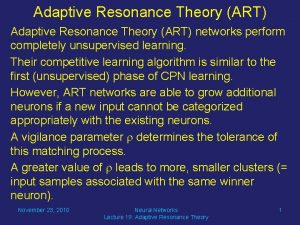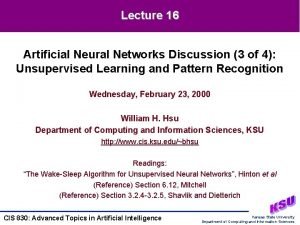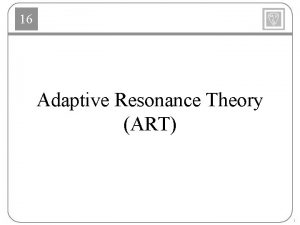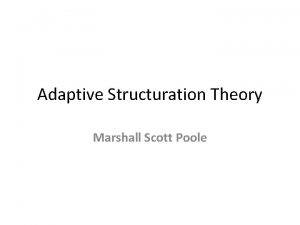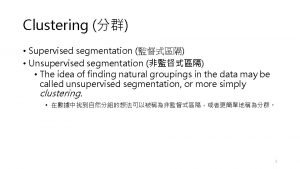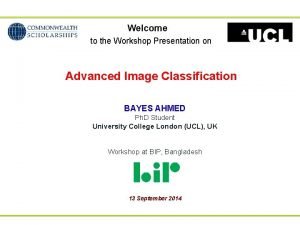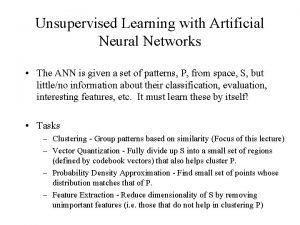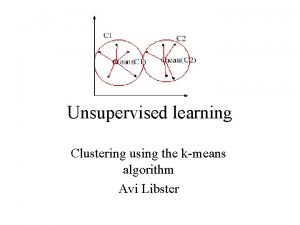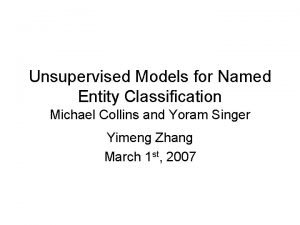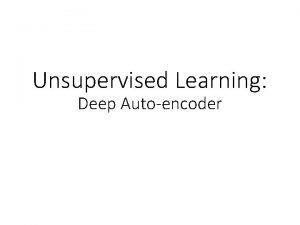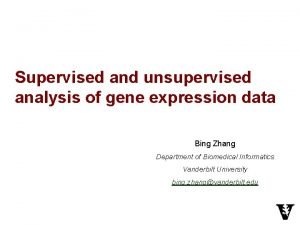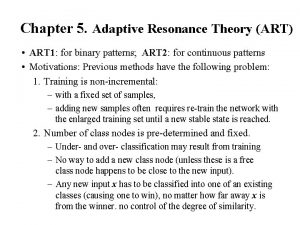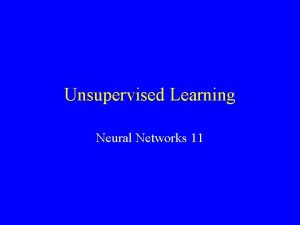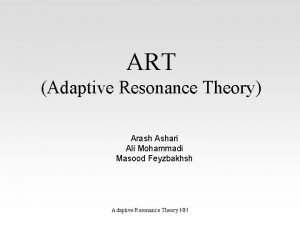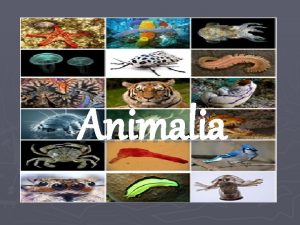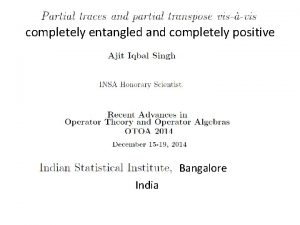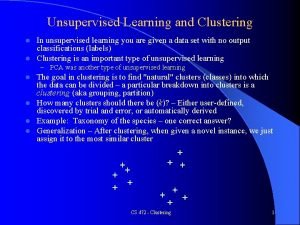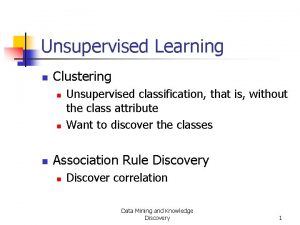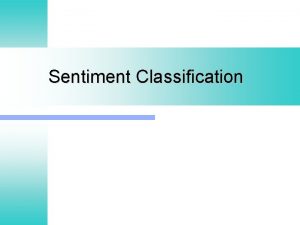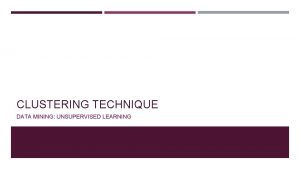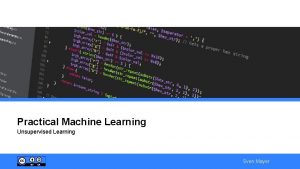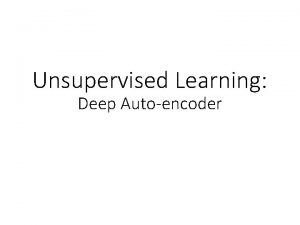Adaptive Resonance Theory ART networks perform completely unsupervised























- Slides: 23

Adaptive Resonance Theory (ART) networks perform completely unsupervised learning. Their competitive learning algorithm is similar to the first (unsupervised) phase of CPN learning. However, ART networks are able to grow additional neurons if a new input cannot be categorized appropriately with the existing neurons. A vigilance parameter determines the tolerance of this matching process. A greater value of leads to more, smaller clusters (= input samples associated with the same winner neuron). November 23, 2010 Neural Networks Lecture 19: Adaptive Resonance Theory 1

Adaptive Resonance Theory (ART) ART networks consist of an input layer and an output layer. We will only discuss ART-1 networks, which receive binary input vectors. Bottom-up weights are used to determine output-layer candidates that may best match the current input. Top-down weights represent the “prototype” for the cluster defined by each output neuron. A close match between input and prototype is necessary for categorizing the input. Finding this match can require multiple signal exchanges between the two layers in both directions until “resonance” is established or a new neuron is added. November 23, 2010 Neural Networks Lecture 19: Adaptive Resonance Theory 2

Adaptive Resonance Theory (ART) ART networks tackle the stability-plasticity dilemma: Plasticity: They can always adapt to unknown inputs (by creating a new cluster with a new weight vector) if the given input cannot be classified by existing clusters. Stability: Existing clusters are not deleted by the introduction of new inputs (new clusters will just be created in addition to the old ones). Problem: Clusters are of fixed size, depending on . November 23, 2010 Neural Networks Lecture 19: Adaptive Resonance Theory 3

The ART-1 Network Output layer with inhibitory connections Input layer 1 November 23, 2010 1 2 2 3 3 Neural Networks Lecture 19: Adaptive Resonance Theory 4 4

A. Initialize each top-down weight tl, j (0) = 1; B. Initialize bottom-up weight bj, l (0) = ; C. While the network has not stabilized, do 1. Present a randomly chosen pattern x = (x 1, …, xn) for learning 2. Let the active set A contain all nodes; calculate yj = bj, 1 x 1 +…+bj, n xn for each node j A; 3. Repeat a) Let j* be a node in A with largest yj, with ties being broken arbitrarily; b) c) Compute s* = (s*1, …, s*n ) where s*l = tl, j* xl ; Compare similarity between s* and x with the given vigilance parameter r if < : r then remove j* from set A else associate x with node j* and update weights: bj*l (new) = tl, j* (new) = Until A is empty or x has been associated with some node j 4. If A is empty, then create new node whose weight vector coincides with current input pattern x; end-while November 23, 2010 Neural Networks Lecture 19: Adaptive Resonance Theory 5

ART Example Computation For this example, let us assume that we have an ART -1 network with 7 input neurons (n = 7) and initially one output neuron (n = 1). Our input vectors are {(1, 1, 0, 0, 1), (0, 0, 1, 1, 0), (1, 0, 1, 1, 0), (0, 0, 0, 1, 1, 1, 0), (1, 1, 0, 1, 1, 1, 0)} and the vigilance parameter = 0. 7. Initially, all top-down weights are set to tl, 1(0) = 1, and all bottom-up weights are set to b 1, l(0) = 1/8. November 23, 2010 Neural Networks Lecture 19: Adaptive Resonance Theory 6

ART Example Computation For the first input vector, (1, 1, 0, 0, 1), we get: Clearly, y 1 is the winner (there are no competitors). Since we have: the vigilance condition is satisfied and we get the following new weights: November 23, 2010 Neural Networks Lecture 19: Adaptive Resonance Theory 7

ART Example Computation Also, we have: We can express the updated weights as matrices: Now we have finished the first learning step and proceed by presenting the next input vector. November 23, 2010 Neural Networks Lecture 19: Adaptive Resonance Theory 8

ART Example Computation For the second input vector, (0, 0, 1, 1, 0), we get: Of course, y 1 is still the winner. However, this time we do not reach the vigilance threshold: This means that we have to generate a second node in the output layer that represents the current input. Therefore, the top-down weights of the new node will be identical to the current input vector. November 23, 2010 Neural Networks Lecture 19: Adaptive Resonance Theory 9

ART Example Computation The new unit’s bottom-up weights are set to zero in the positions where the input has zeroes as well. The remaining weights are set to: 1/(0. 5 + 0 + 1 + 1 + 0) This gives us the following updated weight matrices: November 23, 2010 Neural Networks Lecture 19: Adaptive Resonance Theory 10

ART Example Computation For the third input vector, (1, 0, 1, 1, 0), we have: Here, y 2 is the clear winner. This time we exceed the vigilance threshold again: Therefore, we adapt the second node’s weights. Each top-down weight is multiplied by the corresponding element of the current input. November 23, 2010 Neural Networks Lecture 19: Adaptive Resonance Theory 11

ART Example Computation The new unit’s bottom-up weights are set to the topdown weights divided by (0. 5 + 0 + 1 + 1 + 0). It turns out that, in the current case, these updates do not result in any weight changes at all: November 23, 2010 Neural Networks Lecture 19: Adaptive Resonance Theory 12

ART Example Computation For the fourth input vector, (0, 0, 0, 1, 1, 1, 0), it is: Again, y 2 is the winner. The vigilance test succeeds once again: Therefore, we adapt the second node’s weights. As usual, each top-down weight is multiplied by the corresponding element of the current input. November 23, 2010 Neural Networks Lecture 19: Adaptive Resonance Theory 13

ART Example Computation The new unit’s bottom-up weights are set to the topdown weights divided by (0. 5 + 0 + 0 + 1 + 1 + 0). This gives us the following new weight matrices: November 23, 2010 Neural Networks Lecture 19: Adaptive Resonance Theory 14

ART Example Computation Finally, the fifth input vector, (1, 1, 0, 1, 1, 1, 0), gives us: Once again, y 2 is the winner. The vigilance test fails this time: This means that the active set A is reduced to contain only the first node, which becomes the uncontested winner. November 23, 2010 Neural Networks Lecture 19: Adaptive Resonance Theory 15

ART Example Computation The vigilance test fails for the first unit as well: We thus have to create a third output neuron, which gives us the following new weight matrices: November 23, 2010 Neural Networks Lecture 19: Adaptive Resonance Theory 16

ART Example Computation In the second epoch, the first input vector, (1, 1, 0, 0, 1), gives us: Here, y 1 is the winner, and the vigilance test succeeds: Since the current input is identical to the winner’s topdown weights, no weight update happens. November 23, 2010 Neural Networks Lecture 19: Adaptive Resonance Theory 17

ART Example Computation The second input vector, (0, 0, 1, 1, 0), results in: Now y 2 is the winner, and the vigilance test succeeds: Again, because the current input is identical to the winner’s top-down weights, no weight update occurs. November 23, 2010 Neural Networks Lecture 19: Adaptive Resonance Theory 18

ART Example Computation The third input vector, (1, 0, 1, 1, 0), give us: Once again, y 2 is the winner, but this time the vigilance test fails: This means that the active set is reduced to A = {1, 3}. Since y 3 > y 1, the third node is the new winner. November 23, 2010 Neural Networks Lecture 19: Adaptive Resonance Theory 19

ART Example Computation The third node does satisfy the vigilance threshold: This gives us the following updated weight matrices: November 23, 2010 Neural Networks Lecture 19: Adaptive Resonance Theory 20

ART Example Computation For the fourth vector, (0, 0, 0, 1, 1, 1, 0), the second node wins, passes the vigilance test, but no weight changes occur. The fifth vector, (1, 1, 0, 1, 1, 1, 0), makes the second unit win, which fails the vigilance test. The new winner is the third output neuron, which passes the vigilance test but does not lead to any weight modifications. Further presentation of the five sample vectors do not lead to any weight changes; the network has thus stabilized. November 23, 2010 Neural Networks Lecture 19: Adaptive Resonance Theory 21

Adaptive Resonance Theory Illustration of the categories (or clusters) in input space formed by ART networks. Notice that increasing leads to narrower cones and not to wider ones as suggested by the figure. November 23, 2010 Neural Networks Lecture 19: Adaptive Resonance Theory 22

Adaptive Resonance Theory A problem with ART-1 is the need to determine the vigilance parameter for a given problem, which can be tricky. Furthermore, ART-1 always builds clusters of the same size, regardless of the distribution of samples in the input space. Nevertheless, ART is one of the most important and successful attempts at simulating incremental learning in biological systems. November 23, 2010 Neural Networks Lecture 19: Adaptive Resonance Theory 23
 Adaptive resonance theory example
Adaptive resonance theory example The wake-sleep algorithm for unsupervised neural networks
The wake-sleep algorithm for unsupervised neural networks Resonance theory is
Resonance theory is Virtual circuit approach
Virtual circuit approach Basestore iptv
Basestore iptv Adaptive structuration theory adalah
Adaptive structuration theory adalah Adaptive leadership theory
Adaptive leadership theory Unsupervised learning in data mining
Unsupervised learning in data mining Victor lempitsky
Victor lempitsky Contoh unsupervised learning
Contoh unsupervised learning Lda supervised or unsupervised
Lda supervised or unsupervised Transductive learning for unsupervised text style transfer
Transductive learning for unsupervised text style transfer Autoencoders
Autoencoders Unsupervised segmentation
Unsupervised segmentation Object based image analysis
Object based image analysis Maxnet neural network
Maxnet neural network Is pca unsupervised learning
Is pca unsupervised learning Unsupervised learning
Unsupervised learning Machine learning andrew ng
Machine learning andrew ng Supervised data mining
Supervised data mining Www.youtube.com
Www.youtube.com Unsupervised models for named entity classification
Unsupervised models for named entity classification Greedy layer wise training
Greedy layer wise training Supervised and unsupervised learning
Supervised and unsupervised learning
